
In this second part of Climb Like A Girl, Mick Ryan takes a look at the womens rights movement of the Sixties and its effect on climbing. He introduces Bev Johnson one of Lynn Hill's role models, takes a look at the modern climbing feminist Tori Allen and discusses grade-ism and how some male climbers feel threatened by women climbers.
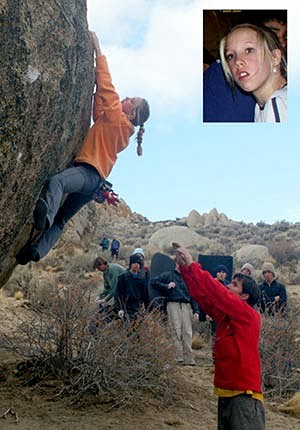
In the US as elsewhere the women's movement of the Sixties and Seventies brought about new rights for women. The vote had been won in 1920 (seventy years after the first women's movement was started in 1848 by Elizabeth Cady Stanton in Seneca Falls, upstate New York), but inequality was still rife in the Sixties. Several great steps forward occurred in this turbulent social period. Birth control pills were given Food and Drug Administration approval in 1960 and in 1964 the Civil Rights Act prohibited employment on the basis of sex which was meant to give women equal opportunities in the work place. In the 70's there was Roe vs. Wade which gave women more reproductive rights and the inclusion of Title 9 in the Education Codes of 1972 gave women equal access to higher education. Title 9 outlawed quotas limiting women's enrollment in graduate schools, consequently the number of women doctors, lawyers, engineers and other professions doubled and doubled again. Title 9 also increased funds and opportunities for women athletes, this had a huge effect on woman's participation levels in sports. Whereas 1 in 27 high school girls played sports 25 years ago, 1 in 3 do today. Today Title 9 is as contentious and important as ever as women still fight for equal opportunities in sport. A significant case involving Title 9 involves the climber and modern feminist Tori Allen. Allen is not only a top performer on rock but also as a pole vaulter and with her father, they are using Title 9 to persuade the Indiana State High School Athletic Association to recognize pole vaulting as a girl's track and field event in Allen's home state, Indiana. This recognition will hopefully increase funds and resources so that Allen, and other women, will have gender equity with men so they will have the opportunity to reach their full potential and have a chance at Olympic selection.
The feminist movement of the Sixties and Seventies, both at the legislative level and more well known at a grassroots street level, gave more and more women the confidence to break out from their stereotypical and culturally imposed roles and encouraged many to enter what had historically been bastions of masculinity. Some woman were even inspired to enter the world of climbing, a left-leaning, fringe sub-culture in the Sixties and nowhere was this sub-culture well-presented than in Yosemite Valley east of radical burn-your-bra San Francisco.

Ann - Maria Rizzi who was a Camp Four resident at the time can rattle off a long list of friends who climbed hard free routes, big walls, and all-women ascents: Matthews, Johnson, Young, Sterner, Hein, Paschall, Wilts, Hechtel, Hargis, Hawkins, Hunter, Devine, Brugger, Frier, Firey, Halvorsen, Woessner, Russell, Robbins, Eastman, Higgins, Bennett, Giller, Bowman, Culliname, Cranor. Perhaps the most well known was the late Bev Johnson who, in 1973, with the accomplished Sybille Hetchel, climbed the Triple Direct up El Cap, the first all-woman ascent of an El Cap route. Roger Breedlove again, "Bev was single, acted independently and was a regular in the Valley. She had a wonderful personality and was easy to be around and to be close to, whether in Squaw Valley for the winter or in the Valley. I think that the reason that she stands out amongst women climbers is that she cut her own path. It was not that she cruised up the hardest climbs, but she carried her own weight and took climbing skills seriously. She was very much part of the core climber's community.
Her nature was self-reliance and self-motivation. And she was tough as nails. But she could also turn on the Southern, debutante charm in an instant. One argument she won with me was about "Why should women get their own kudos when they do a first female ascent? If women are serious about equality, then they should compete directly with men." These were still the early years of women's liberation. I was still learning the hard lessons of leading with my chin. She instantly softens her pose, tilted her head, did a slow bat of her eyes, and drawled sweetly: "Ah, come on, Roger. Can't we have our own little category?"
Indeed should women have their own category? That is a question which provokes much disagreement. If women posses the potential, both physically and mentally, to climb at the highest levels as shown by Lynn Hill, Beth Rodden, Josune Bereziartu and Jan Conn, why do women need their own categories? Do separate categories like first all-woman ascent and first female ascent signify that women are less able than men? Or do they, like She Sends magazine and women-only climbing courses offer encouragement to women in what has been traditionally the domain, almost exclusively, of men? Whilst women's rights, like black civil rights, have made tremendous progress in the last forty years, inequality and discrimination is still rife, maybe its time for a little affirmative action where preferential treatment is given to make amends for past injustices, at least until more balance is reached.
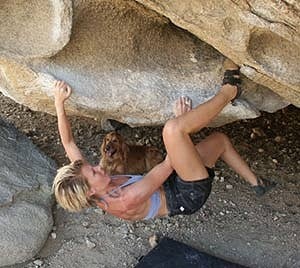
The climbing magazines have role to play here. Paralleling the increase in the numbers of women climbing has been an increase in women in the climbing magazines. Achievements of the top women are reported in the mags as they are newsworthy and advert-attracting, although you do hear some dissent from some top women as regards the fairness of coverage, but it's at the grassroots level where something is amiss.
Fern Webb, a climber of 8 years from Vancouver, did her own research. "A couple years ago I went through my collection of Climbing and Rock & Ice magazines to do a cursory tabulation of the number of female-focussed articles. Basically any article by or about a woman. I had heard from a few people that their perception was that women had very little presence in those mags, but I hadn't really noticed the gap myself so I looked through the back issues with that particular bias in mind. I was pretty surprised actually that there were quite a few articles by and about women - but what frustrated me so much that I abandoned the project after about a dozen issues, was that for the most part the articles didn't have a very positive message. Many were about accidents or mistakes, some about eating disorders, bad relationship issues, etc. Certainly those are important issues, but there was little balance with just simple positive articles."
One British climber, Lucy Creamer has suggested that more achievements of women climbers are reported, not just the achievements of the "superwomen ", but what would be considered everyday ascents by men. The theory being that, whilst many climbers may not be able to achieve the dizzy heights of V15 and 5.14, they may be encouraged to put the extra effort in and gain the extra rewards, if they see more reports of women doing V7 and 5.12.
When you mention such positive encouragement you do get the inevitable backlash. Whilst the climbing community is more enlightened and egalitarian than most sections of society there is still much negativity if you mention special treatment or even a little extra encouragement for women.
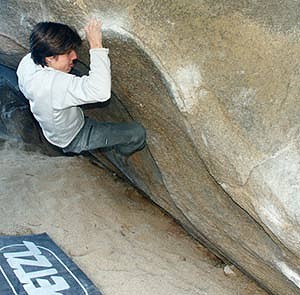
Much of this is to do with the image of the women's rights movement and especially the word feminist. The myth of the feminist in popular culture is of a politically-correct bra-burning crew-cut dyke in dungarees reading women's-only "empowering " poetry in a room full of other similarly hairy-legged women, the Mili-tant of Viz magazine, the men-haters who demand a man-free space. The "wimmin power", "estrogen-fest" that so turns Elyse Brandt off when thinking of all-women climbing clinics like Chicks On Cracks.
"Feminist? " some males say, "Oh! Must be a lesbian. " Whilst this stereotype is the butt of many jokes it does encourage some not to take sexism and discrimination seriously.
On the other hand it doesn't help when even using a "wrong " word can provoke ire from some women. When I was a young science teacher in North Yorkshire I gave a slide show on climbing to the school morning assembly. In the presentation I showed some pictures of women climbing and I mentioned that Lynn Hill was the best 'lady' climber in the world. At first break whilst mindlessly photocopying some worksheets I was surrounded by a group of women who severely admonished me for the use of 'lady' and they quickly educated me on its subservient meaning, and recommended that I use 'women' when talking of the opposite sex. But even 'women' to the radical feminists is offensive because it contains the word 'men' and there was once a movement to replace 'women' with 'wimmin'.
Some women are their own worst enemies of course, Hilary Clinton didn't win any favors when she looked down her nose at women who stayed home and baked cookies. The successes of the women's rights movement has seen a backlash not just from men but from women and two-thirds of American women refuse to call themselves feminists no doubt because of feminist extremism. There's even two anti-feminist women's organizations, the Total Women Movement and the Fascinating Women Movement, who advocate women's return to traditional attitudes, values and roles even so far as encouraging women to be sex objects and "to surprise their husbands by meeting them at the door dressed only in saran wrap. "

In reality of course feminist extremism, or anti-feminism, is not what the woman's rights movement is about. Men have ruled the earth for the last five million years to their advantage. The mainstream woman's movement has always been about acknowledging the very real differences between men and women but at the same time re-addressing the balance of equality and power, gender equity to use its proper feminist nomenclature. Great gains have been made, made by the bra-burning radical feminist and the more liberal mainstream feminists: women have the vote, they have property rights, divorce and custody law is more equal, women have equal opportunity in schools, sports and the workplace, and more parity in social, personal, financial and sexual issues; reproductive rights, domestic violence, rape and incest are on the public agenda. These gains were not made in some long distant past but fairly recently, consider that 25 years ago married women were not issued credit cards in their own name, or that most women couldn't get a bank loan without a male co-signer. If you want to consider how far off true equality is and if you think, like many, that the feminist battles have all been won consider how much violence against women is perpetrated by men. Whilst writing this article I read of two women who were murdered, one in New York in a parking lot by her estranged husband, and another in Texas by her husband outside a divorce proceeding. Do all men accept that women are free to choose what role they want to engage in? Consider that in 1991, a male engineering student at the Université de Montreal, Canada, massacred fourteen women because he felt that engineering was a man's field in which women had no rightful place. Gender bias is still very much alive in the workplace and elsewhere, and sadly violence against women by men is very real.
Even in the egalitarian climbing world you may have experienced sexism, both overt and subtle, deliberate and through ignorance, it does rear its head on occasion. Many men make the mistake of lowering their expectations of women. I'm sure many women have experienced the presumptuousness of men as regards their ability and technical skill, as if all women are beginners. Hands up who hasn't witnessed male climbers barking out instructions to women climbers when none were asked for? Tiffany Skogstrom's experience, a climbing mom from New Hampshire, is common, "These guys were too pumped to get their draws of a sport climb. I was flaking the rope while my husband ran off to relieve himself. One of the guys asks if my husband would mind retrieving the gear when he gets back. I said I would be happy to lead it and get them back for them. The guy rather hesitantly says "okay " and then proceeds to instruct me on what to do when I get to the top. "
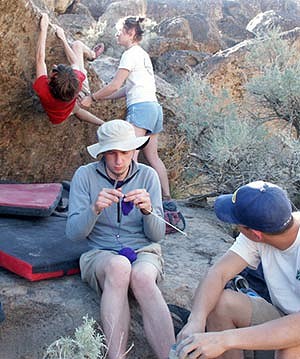
Even when women do perform at the highest levels there is sometimes disbelief, and often suspicion that they have in somehow cheated in attaining a level that was once only the domain of men. According to some it was only because of her small fingers that Lynn Hill was able to free climb El Caps Nose Route. Recently Lisa Rands climbed several significant bold "headpoint style " gritstone routes that have always been led after top rope practice. Rands achievements were demeaned in some quarters because she, just like all the male ascents before her, had used the same practice of prior rehearsal. Such is the extent of the backlash that women aren't even judged by the same standards as men but have to surpass them if they are to be acknowledged.
Then there is grade-ism. One of the most noted episodes of downrating climbs after a girl had led a climb was in Yosemite. If Bev Johnson could follow a 5.11 the men would down-rate it to 5.10, this was known as the 'Bev rating system' or 'girl standard' and it is still rife thirty years on. Recently Lisa Rands competed in the Horse Pens 40 bouldering competition in Alabama. Prior to the event one of the organizers toured Horse Pens with Lisa and she pointed out problems she had flashed or done on previous visits. On the day of the event all these problems had been mysteriously down-rated a grade.
Whilst such examples of climbing sexism can be explained by the insecurity of some men frightened by the loss of their prowess and dominance in the climbing world and can be laughed off by the more thick-skinned we are all aware of men judging and passing comment on women's body and looks. On ukclimbing.com recently the tale was recounted how a group of men at the Roaches (a gritstone outcropping in the UK) were returning to their car and passed two women climbing. Like the stereotypical construction site worker they broke into wolf-whistles and cat-calls, hardly the behavior expected of enlightened climbers. More often than not this takes place in the privacy of small groups as it always has and will. But go to some climbing websites and behind a veil of anonymity on the very public internet you will witness long threads containing images of "Hot Babes Who Climb" where women are rated on a scale of 1 to 10 and labeled as hot or not, minger or babe, as regards whether the expression of their genes conforms to a notion of beauty perpetrated by society. The mob mentality is always cruel and heartless. For some in the climbing media, and some of their advertizers this has not gone un-noticed.







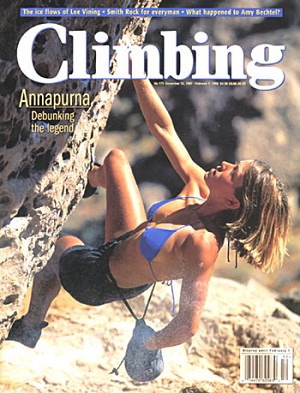
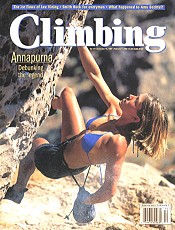
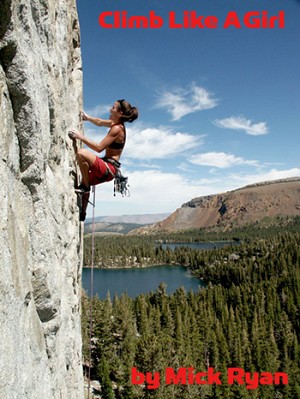
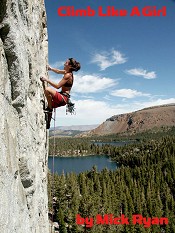
Comments